2024 National Findings Report
Creating Thriving Communities Through Civic Participation
Introduction

All people have the right to live long and well. People who encounter barriers to health and have ideas to improve health have the right to raise the issue, engage with their community and expect action to be taken.
This year, we continue to focus on the connection between civic participation and health, called civic health. Evidence shows that participating in our communities, whether through volunteering or joining neighborhood groups, strengthens our social connections and sense of belonging which in turn, benefits our physical and mental health. Civic participation in political or electoral processes through voting or organizing can also influence policies that create opportunities for health, including safe spaces to live and work and funding for public health initiatives.
This report highlights the importance of civic infrastructure, spaces to connect and be informed, with a focus on access to local news, broadband internet and public libraries. We call attention to structural barriers like policies, laws and practices that can create obstacles to forms of participation such as voting and worker unionizing.
Key takeaways
- The healthiest counties, where people live long and well, have well-resourced civic infrastructure, including a more accessible information environment (local news outlets, broadband access and public libraries), compared to counties among the least healthy. Counties with well-resourced civic infrastructure and accessible information environments also offer more social and economic opportunity for good health. In these counties people have higher rates of participation, such as voting or union membership, and people tend to live longer.
- Civic infrastructure, including accessibility of the information environment, is under-resourced among counties along the U.S.-Mexico Border, within the Black Belt Region and Appalachia and surrounding American Indian/Alaska Native tribal areas. These regions of our country bear a legacy burden of various forms of disinvestment and structural racism. This means less access to civic spaces to connect, engage in public issues and solve problems that harm everyone’s health.
- Regions of our country that erect or reinforce structural barriers to civic health — or discriminatory policies and practices, such as laws that create obstacles to voting — limit participation in civic life. These structural barriers are more common in regions with specific histories of structural racism and disinvestment. Rates of voter turnout and union membership are lower among counties here compared to other regions. And, life expectancy is, on average, more than three years shorter in counties with more structural barriers compared to those with fewer barriers (74.1 years vs. 77.6 years, respectively). These findings illustrate that everyone’s health is implicated when we exclude people and communities from participating.
People and places thrive when everyone can participate
Civic health reflects the opportunities people have to participate in their communities. It welcomes everyone’s voice to set priorities, make decisions and share resources. Civic health begins with our local communities and is the cornerstone of our democracy, embodying hope, opportunity, belonging and shared responsibility.
We look at two elements of civic health:
- Civic infrastructure provides us with spaces to meet, make our voices heard, engage in cultural activities and assure belonging. How we cultivate these spaces is also a part of infrastructure. This requires intentional policies and practices to create and cultivate environments where everyone can exchange ideas and solve problems together.
- Civic participation includes the ways people engage in community life to improve conditions, whether through voting, advocacy, volunteering, mentoring or participating in unions so that their work can meet their basic needs. Supporting ways to participate is foundational to building healthy, thriving and equitable communities.
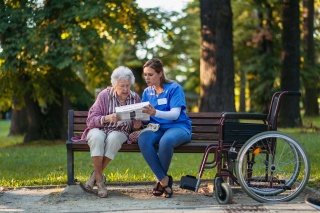
Civic infrastructure supports connection within communities and makes civic participation possible. Civic infrastructure encompasses places such as libraries, parks and schools and access to information needed for individual and group decision-making.
Despite the strong links between civic participation and our health, disinvestment in or deliberate exclusion from our civic infrastructure means that not everyone can participate. Structural barriers such as policies, laws and practices can create obstacles to forms of participation such as voting and worker unionizing. Structural barriers, such as limited infrastructure to support public deliberations, can also be obstacles to authentic community input into decisions.
Investing in an accessible and high-quality information environment can foster inclusive and informed participation in our communities, a critical component of a healthy democracy. Creating spaces where everyone has a voice supports conditions where everyone can thrive. On the other hand, exclusionary practices, such as laws and practices that limit voting and organized labor, can be detrimental to health.1
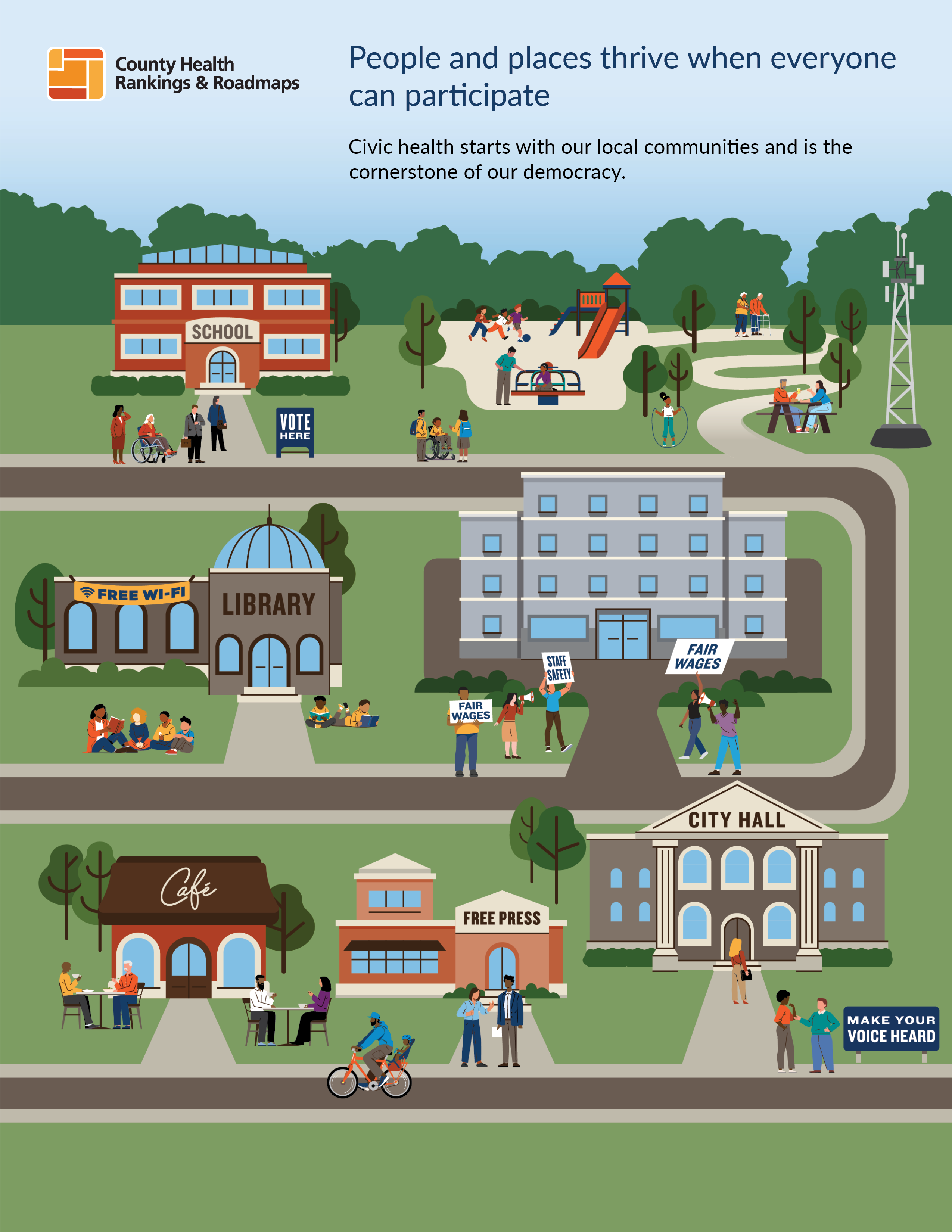
Broadband initiatives expand high-speed internet access, affordability and internet use. Broadband provides opportunities to engage and connect with others and supports people’s access to employment and quality health care.
Unions consist of workers organized to use their voice to bargain collectively for improved wages, benefits and working conditions. Union membership can increase political knowledge and participation. Unions achieve these goals and reduce discrimination and wage disparities by race and gender, all of which improves workers' health. In society, unions can reduce income inequality and improve wages and benefits generally.
Participatory budgeting engages community members to determine how public budgets are spent. Broad involvement can improve neighborhood conditions and combat poverty, especially when everyone in the community has had the opportunity to participate and have a say over a substantial portion of the budget.
Public deliberations are facilitated dialogues among people with diverse values and perspectives around a topic of public concern. Deliberations grounded in evidence can decrease polarization and increase civic participation. Deliberations have the potential to result in solutions that create healthier communities.
Public libraries lend materials, offer gathering space, and provide educational, civic and social programming for communities. Libraries can increase social capital, community involvement and improve access to health and social services.
Voter registration initiatives
Voter registration initiatives include automatic voter registration, registration drives, easing registration requirements and expanding the types and number of sites where people can register. Automatic voter registration is the most effective way to increase voting. States with more accessible voting policies are linked to better quality of life and longer life expectancies.
Voter turnout initiatives include get-out-the vote campaigns, early in-person voting, vote-by-mail and expanding polling locations and hours. All can increase voting. Early in-person voting especially increases voting among groups who normally experience obstacles to voting. Vote-by-mail increases voting and political participation without evidence of partisan advantage. States with higher voter turnout are linked to better quality of life and longer life expectancies.
Youth civics education teaches K-12 students the knowledge and skills needed to participate in a democracy. Civics education can develop students’ skills in reasoning and respectful discussion and may increase young people’s civic participation, civic knowledge and voting rates. Higher voter turnout leads to better quality and longer life expectancies.
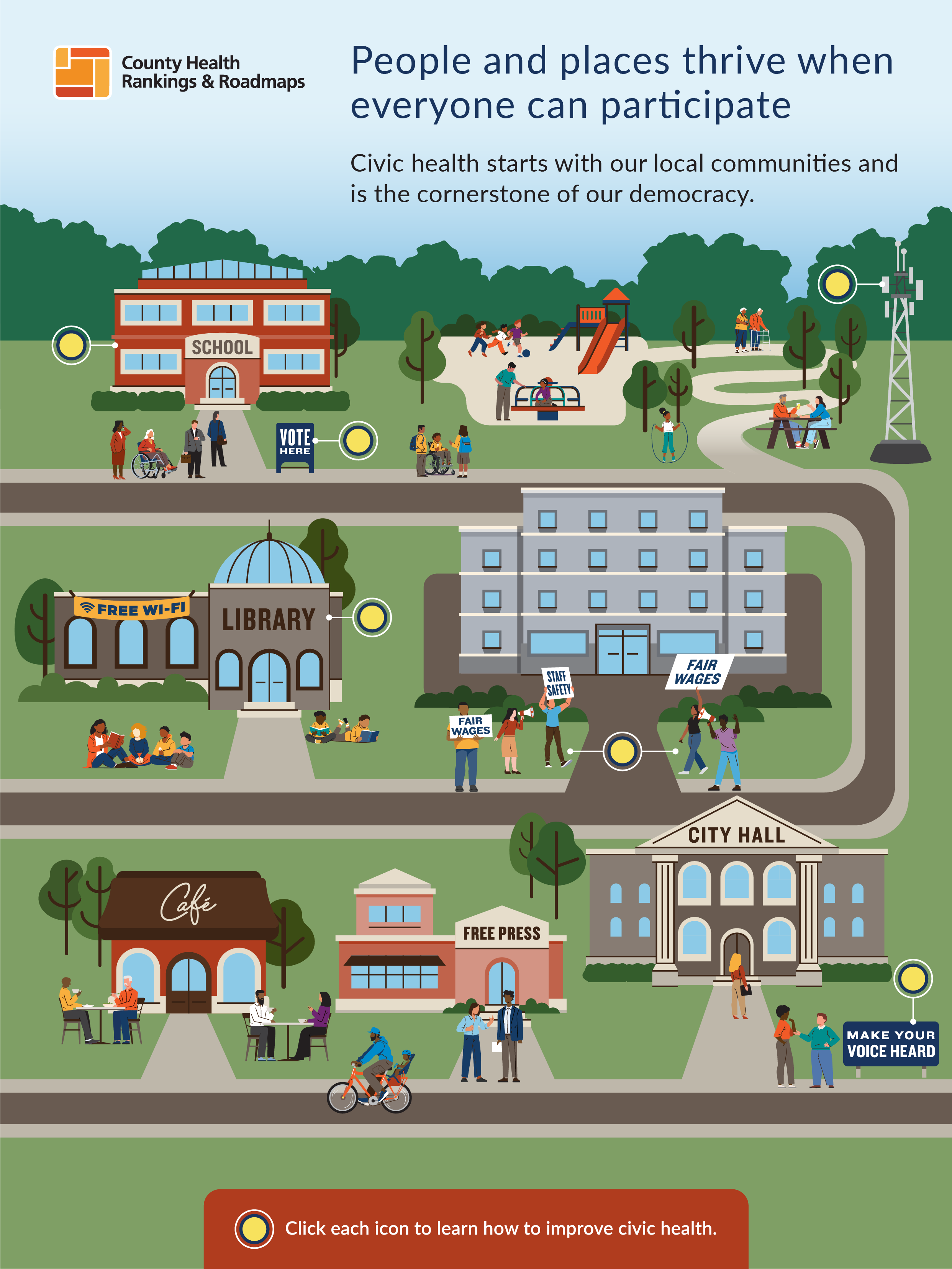
Broadband initiatives expand high-speed internet access, affordability and internet use. Broadband provides opportunities to engage and connect with others and supports people’s access to employment and quality health care.
Unions consist of workers organized to use their voice to bargain collectively for improved wages, benefits and working conditions. Union membership can increase political knowledge and participation. Unions achieve these goals and reduce discrimination and wage disparities by race and gender, all of which improves workers' health. In society, unions can reduce income inequality and improve wages and benefits generally.
Participatory budgeting engages community members to determine how public budgets are spent. Broad involvement can improve neighborhood conditions and combat poverty, especially when everyone in the community has had the opportunity to participate and have a say over a substantial portion of the budget.
Public deliberations are facilitated dialogues among people with diverse values and perspectives around a topic of public concern. Deliberations grounded in evidence can decrease polarization and increase civic participation. Deliberations have the potential to result in solutions that create healthier communities.
Public libraries lend materials, offer gathering space, and provide educational, civic and social programming for communities. Libraries can increase social capital, community involvement and improve access to health and social services.
Voter registration initiatives
Voter registration initiatives include automatic voter registration, registration drives, easing registration requirements and expanding the types and number of sites where people can register. Automatic voter registration is the most effective way to increase voting. States with more accessible voting policies are linked to better quality of life and longer life expectancies.
Voter turnout initiatives include get-out-the vote campaigns, early in-person voting, vote-by-mail and expanding polling locations and hours. All can increase voting. Early in-person voting especially increases voting among groups who normally experience obstacles to voting. Vote-by-mail increases voting and political participation without evidence of partisan advantage. States with higher voter turnout are linked to better quality of life and longer life expectancies.
Youth civics education teaches K-12 students the knowledge and skills needed to participate in a democracy. Civics education can develop students’ skills in reasoning and respectful discussion and may increase young people’s civic participation, civic knowledge and voting rates. Higher voter turnout leads to better quality and longer life expectancies.
Building power to break down structural barriers for everyone's health and well-being
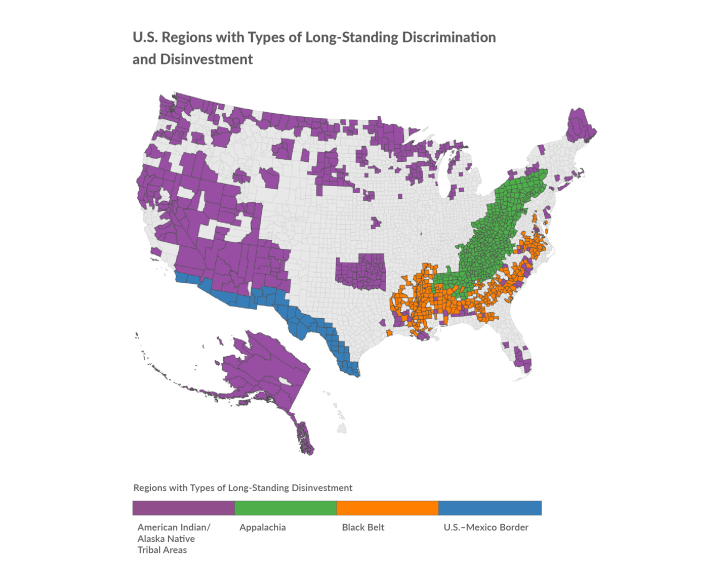
Healthy communities depend on a culture where all people have the power to make change and a say in the decisions that affect them.
But not all U.S. communities have the same opportunities for civic health. Many groups, including women, immigrants, LGBTQIA+ people and racialized groups such as Native people, Black and Hispanic populations experience the impacts of a history of disinvestment in civic infrastructure. They have also faced exclusionary policies and practices that limit opportunities to participate through a variety of means including restrictive voting laws. Redlining, disinvestment in rural economies and legal actions to terminate tribal culture and land rights are examples of long-standing discrimination that have created structural barriers to social and economic opportunity, civic participation and the potential to live long and well in these communities today (see map at right).
Despite this enduring history, change is possible. Structural barriers can be dismantled through voting, ballot initiatives, volunteering and union and community organizing. Civic participation that builds power to break down structural barriers can benefit the health and well-being of everyone.
We can advance health and equity when all people have a say in their futures. To provide these opportunities, we must undo policies, practices and worldviews that exclude people from participating in decisions about how to create heathy communities.
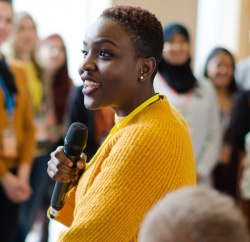
History shows that when marginalized groups build power, changes that result can benefit the health and well-being of all.
Union membership has shown the promise of uniting people with limited power to accomplish changes that benefit everyone. Labor unions were instrumental in ending child labor and decreasing occupational fatalities. A strong body of research shows that higher union membership rates are associated with increased wages for all workers and reduced income inequality over time.2 Despite these benefits, unions are at risk. Policies such as the 1947 Taft Hartley Act and state Right-to-Work laws have restricted the power of unions and contributed to declines in union membership. These policies are often supported by corporations and their legislative allies.
Broad access to accurate and timely information supports thriving communities and democracy
Democracy requires an informed public. The information environment is the space where people obtain information to make sense of the world. This includes digital and non-digital resources that shape information flow and the conditions for people to access, process and absorb information. The information environment involves things like access to broadband internet, local news and public libraries. The information environment requires structural protections, such as preservation of the First Amendment right to freedom of speech, a free and independent press, and protections against disinformation.
The quality and accessibility of the information environment matters because it is tied to our health and is crucial infrastructure for civic participation. Some people do not have access to the information, resources and services that support health, nor the ability to raise issues in their communities because they lack sufficient access to various types of information. The information environment is in transition, which presents opportunities and risks.
- News media outlets provide a first draft of history and serve as a watchdog that holds those in power, including public officials, accountable. People with access to local news vote more and, in some communities, local news may be the only source for information about public decisions like budgets, planning and other deliberations. However, local newspapers are disappearing and large news outlets are laying off reporting staff. Nine out of 10 adults in the U.S. get at least some of their news online3 and many sites recycle their news from traditional news media — mostly from larger urban newspapers.
- Broadband internet access is uneven across the country. Pockets of rural, lower-income, marginalized and racialized communities have the least reliable access. This is due in part to disinvestment in rural economies and digital redlining, as described below. Broadband internet access enables people to seek job opportunities, education, online medical care and can also decrease loneliness and social isolation. Broadband internet access can support civic participation, as seen by the rise in virtual town halls where people can have their voices heard and learn about issues.
- Public libraries are unevenly funded, particularly in rural and lower-income urban areas. In recent years, some public libraries have also faced defunding and attempts to censor library materials.4 Public libraries promote health by lending reading materials, providing access to broadband internet, offering classes and programming, connecting people to health and social services and serving as community hubs during disasters. Libraries are often sites for community meetings and voting.

Many laws and policies that underlie current barriers to health have historical roots and are still contested today.
For example, the pattern of limited and unreliable broadband access across some communities can be traced to redlining from the 1930s when the Federal Housing Administration created maps that reinforced segregation by rating the neighborhoods with Black and immigrant residents as risky real estate investments. This disinvestment continues today and has expanded to include digital redlining, which occurs when large network providers exclude lower-income neighborhoods and communities. Consequences for these disconnected communities, which are disproportionately made up of Black residents, impact the health and well-being of everyone living there.
Transitions within our information environment did not occur solely due to consumer preferences. These changes are structural in nature and often — though not always — serve to maintain current economic and political power through their implementation.
All these changes matter. The information environment is key to transmitting evidence-informed knowledge of issues relevant to health to the public via trusted messengers. It is also important in our understanding of the needs and opportunities in our communities. The information environment influences our actions, whether communications are about the importance of vaccinations or confidence in who we elect to make decisions on our behalf.
A closer look
- Civic infrastructure varies across U.S. counties. The healthiest counties, as measured in length and quality of life, have well-resourced civic infrastructure, including a more accessible information environment (local news outlets, broadband access and public libraries), compared to counties among the least healthy.
- Counties with well-resourced civic infrastructure, including a more accessible information environment, also offer more social and economic opportunity for good health. This includes lower rates of children in poverty, less income inequality, and lower rates of uninsured adults, along with higher rates of high school completion and more adequately funded schools. Counties with well-resourced civic infrastructure also have higher rates of participation, such as voter turnout or union membership.
- The northeast and western regions of the U.S. have more accessible information environments, including more access to broadband internet and local news outlets. Counties in the southern region have the least accessible information environments (see map, below). Regions with long-standing discrimination and disinvestment, such as the Black Belt, Appalachia, the U.S.-Mexico border and surrounding American Indian/Alaska Native tribal areas, also have less access to the information environment than counties outside of these regions. This means that people living in these regions have fewer opportunities to engage in civic life.
These findings reveal a familiar pattern: the conditions that support civic health can often be found in the same places and are often missing from other places. While correlation does not equal causation, these patterns are not coincidental. In the section that follows, we call attention to how opportunities that are either missing or present often reflect how people and groups who hold more power shape rules and how they are applied. These rules reproduce certain values and beliefs about how society should work and who should benefit or carry burdens.
Characteristics of the Information Environment Across U.S. Counties
Scroll within the box below to learn more about the information environment and explore your county's data.
Explore webinars, podcasts, blogs and reports to learn about civic health and ways to create communities where everyone can thrive. Tune in for conversations with experts from around the country on how the fields of public health and health care can improve civic health, youth civics education, participatory budgeting, building community power and more.
Taking action
We have the power to create places where all people can participate. We can invest in inclusive public spaces that encourage participation and cultivate vibrant communities that enable people to connect with each other and access formal decision-makers. Examples of evidence-informed strategies include:
- Broadband initiatives
Broadband initiatives expand high-speed internet access, affordability and internet use. Broadband provides opportunities to engage and connect with others and supports people’s access to employment and quality health care. - Public libraries
Public libraries lend materials, offer gathering space and provide educational, civic and social programming for communities. Libraries can increase social capital, community involvement and improve access to health and social services. - Participatory budgeting
Participatory budgeting engages community members to determine how public budgets are spent. Broad involvement can improve neighborhood conditions and combat poverty, especially when everyone in the community has had the opportunity to participate and have a say over a substantial portion of the budget. - Public deliberations
Public deliberations are facilitated dialogues among people with diverse values and perspectives around a topic of public concern. Deliberations grounded in evidence can decrease polarization and increase civic participation. - Youth civics education
Youth civics education teaches K-12 students the knowledge and skills needed to participate in a democracy. Civics education can develop students’ skills in reasoning and respectful discussion and may increase young people’s civic participation, civic knowledge and voting rates.
Explore a curated list of evidence-informed strategies to improve civic health.
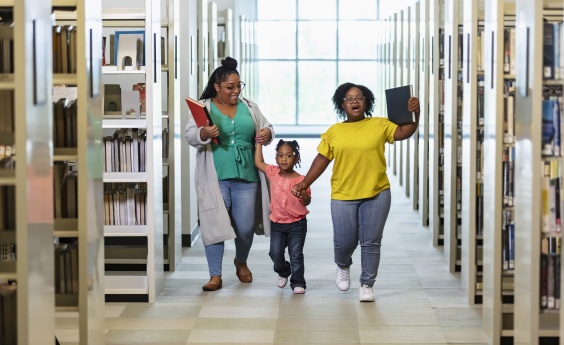
We all lose when we disinvest in civic spaces and information environments that serve everyone.
Some libraries in the U.S. experienced attempts to reduce staff and funding because they made certain materials available, thereby removing a vital public resource for all.5 In 2023, the American Library Association reported 695 attempts to censor library materials and challenges to almost 1,915 unique titles, which was a 20% increase from the same reporting period in 2022. Most of the challenges were to books written by or about a person of color or a member of the LGBTQIA+ community.6 Book banning as a form of censorship in the information environment has deep historical roots. In 18th and 19th century America, religious groups pushed to ban books they considered immoral. Many Southern states banned anti-slavery books.
Breaking down structural barriers to health
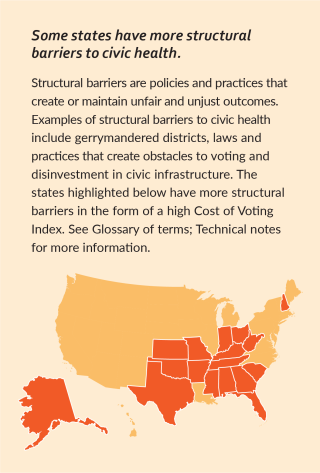
Everyone’s health is affected when we exclude people and communities from participating.
Policies and practices shape whether and how we participate in our communities. They can make it easier to participate, limit participation for everyone or systematically exclude some populations. Take voting and union membership, for example:
- Almost 67% of the voting-eligible population participated in the 2020 presidential election, the highest since 1900.7 In 2023, in response to increased participation, 14 states enacted laws making it harder to vote and 23 states passed laws making voting more accessible.8
- Labor organizing has its roots in creating working conditions for improved health. As a result of the expansion of Right-to-Work policies, decreased enforcement of labor laws and other factors, union membership has declined from 34% of the worker population in 1954 to about 10% today.9
A geographic pattern of barriers keeps people and communities from participating in the decisions that affect their lives. These barriers are structural in nature, meaning they are embedded in the rules of our society. Limiting people’s opportunities worsens health outcomes.
A closer look
- Structural barriers to civic health, such as laws that make voting more difficult, limit participation in civic life. Counties within states and regions with more structural barriers to participation show signs of lower rates of voter turnout, census participation and union membership (see interactive map below).
- Structural barriers to civic health are also associated with poorer social and economic environments and poorer overall health. In counties with more structural barriers to civic health, life expectancy from birth is, on average, more than three years shorter than in counties with fewer barriers (74.1 years vs. 77.6 years, respectively) (see interactive map below).
- States with more accessible voting policies and higher voter turnout are linked to better quality of life and longer life expectancies.
- Structural barriers to civic health are more common in regions of our country with specific histories of structural racism and disinvestment, particularly in the South.
Voter Turnout and Life Expectancy Across U.S. Counties and Among States with More Structural Barriers to Civic Health
Scroll within the box below to learn more about structural barriers and to explore your county's data.
Learn how you can use What Works for Health to find evidence-informed policies and programs that can make a difference in your community and explore what is behind our evidence ratings.
Curated strategy lists can be helpful resources to support community change efforts around specific topics and themes. Each list includes evidence-informed programs, policies and systems changes that can help address complex health problems, systemic social issues and local community needs and priorities.
Taking action
We all play a role in nurturing civic health. Individual actions — calling your representative to advocate for a policy, helping your neighbor register to vote, hosting a community event at a library — can lead to broader community change. Collective action can have an even greater impact in advancing civic health.
- Labor unions
Unions consist of workers organized to use their voices to bargain collectively for improved wages, benefits and working conditions. Union membership can increase political knowledge and participation. Unions achieve these goals and reduce discrimination and wage disparities by race and gender, all of which improves workers’ health. In society, unions can reduce income inequality and improve wages and benefits. - Voter registration initiatives
Voter registration initiatives include automatic voter registration, registration drives, easing registration requirements and expanding the types and number of sites where people can register. Automatic voter registration is the most effective way to increase voting. - Voter turnout initiatives
Voter turnout initiatives include get-out-the vote campaigns, early in-person voting, vote-by-mail and expanding polling locations and hours. All can increase voting. Early in-person voting especially increases voting among groups who normally experience obstacles to voting. Vote-by-mail increases voting and political participation without evidence of partisan advantage.
Glossary of terms & technical notes
Glossary of terms
Civic health: The degree to which citizens participate in their communities, from local and state governance to interactions with friends or family. Civic health relates to the overall well-being of neighborhoods, communities, states and the nation (National Conference on Citizenship 2023).
Civic infrastructure: Places, policies, programs and practices that undergird strong communities and foster civic participation (Patrick and Brady 2015).
Civic participation: The ways people participate in the life of a community in order to improve conditions and/or shape the community’s future (Adler and Goggin 2016).
Community power: The ability of communities most impacted by structural inequity to develop, sustain and grow an organized group of people who act together through democratic structures to set agendas, shift public discourse, influence who makes decisions and cultivate ongoing relationships of mutual accountability with decision-makers that change systems and advance health equity (Lead Local 2023).
Democracy: A form of government where citizens elect leaders to govern on their behalf.
Digital redlining: The modern equivalent of this historical form of redlining creates and maintains technological policies, practices and investment decisions that enforce class boundaries and discriminate against specific populations. For example, this entails under-resourced broadband infrastructure in low-income and rural areas and neighborhoods, often with high proportion of people of color (Gilliard and Culik 2016).
Health equity: Assurance of the conditions for optimal health for all people. Achieving health equity requires valuing all individuals and populations equally, recognizing and rectifying historical injustice and providing resources according to need (Jones 2014).
Information environment: The space where people process information to make sense of the world. This includes the digital and non-digital resources that shape information flow and the conditions for people to access, process and absorb informatio(Center for Democracy & Technology n.d.).
Redlining: The Federal Housing Administration’s policies from the 1930s that entrenched racial residential segregation. Redlining denied Black people and some other ethnic groups access to government-insured mortgages and labeled homes in neighborhoods where Black people and some other ethnic groups lived as uninsurable, thereby guaranteeing that property values in those neighborhoods would be less than those in non-immigrant white neighborhoods (Mapping Inequality n.d.).
Right-to-Work policies: These policies prohibit unions from collecting dues from non-unionized workers in otherwise unionized workplaces, which weakens the scope of collective action and deprives unions of funds to exert political influence to support workers (Frymer, Grumbach and Hill 2023).
Social solidarity: Emphasizes the interdependence between individuals in a society, which allows individuals to feel that they can enhance the lives of others. It is a core principle of collective action and is founded on shared values and beliefs among different groups in society (Douwes et al. 2018).
Structural barriers: Obstacles that collectively affect a group disproportionately and perpetuate or maintain stark disparities in outcomes (American Hospital Association Institute for Diversity and Health Equity n.d.).
Structural racism: Refers to the totality of ways in which societies foster racial discrimination through mutually reinforcing systems of housing, education, employment, earnings, benefits, credit, media, health care and criminal justice. These patterns and practices in turn reinforce discriminatory beliefs, values and distribution of resources (Bailey et al. 2017).
Find more information and relevant readings on civic health.
Technical notes
Definitions for regions and county categories:
The Appalachian Region is defined as the 423 counties across 13 states from southern New York to northern Mississippi that span the Appalachian Mountain range and are served by the Appalachian Regional Commission.
The Black Belt Region is defined as the 285 counties in the southern region of the U.S. that have populations where greater than or equal to 30% of their residents identify as non-Hispanic Black or African American alone, according to the 2020 decennial census.
The U.S.-Mexico Border Region is defined as the aggregate of 44 counties within 100 kilometers (or 62.5 miles) of the international boundary, stretching 2,000 miles from the southern tip of Texas to California.
AI/AN tribal areas and their surrounding counties is defined as counties where any part of the county includes an American Indian or Alaska Native tribal area as delineated by the U.S. Census Bureau.
Data sources and measures
Structural Barriers: Data sources for structural barriers include the 2020 Cost of Voting Index (COVI) and the State Democracy Index. The 2020 COVI, which measures the relative difficulty of voting in each state, was created from nine issue areas, including: registration deadlines, registration restrictions, registration drive restrictions, pre-registration laws for 16 and 17 year olds, automatic voter registration, voting inconvenience, voter ID laws, poll hours and early voting. The State Democracy Index, which measures the quality of democratic institutions in states, uses 51 democracy indicators, such as measures of gerrymandering, electoral policies that affect the eligibility to or cost of voting, electoral policies that increase the integrity of elections and observed democratic outcomes. We stratified the COVI into tertiles for analyses capturing more or fewer structural barriers.
Libraries: Data on library use come from the Public Libraries Survey for 2021 conducted by the Institute of Museum and Library Services. Note: the impact of the COVID-19 pandemic likely affected library operating hours and use in 2021.
News Outlets: Data on the availability of local news outlets come from the Medill Local News Initiative at Northwestern University’s “The State of Local News” 2023 report.
Volunteering: Data on volunteering at the state level come from the 2021 Current Population Survey Civic Engagement and Volunteering Supplement conducted by the U.S. Census Bureau and AmeriCorps.
Union Membership: Data on union membership at the state level come from the 2023 Current Population Survey and the U.S. Bureau of Labor Statistics.
We define the healthiest and least healthy counties as those that scored among the 10th (least healthy) and 90th (healthiest) percentile counties, nationwide, for the 2024 Health Outcomes z-score.
Download maps & figures
Footnotes
- See the relevant reading list for select research studies relevant to this report.
- Leigh JP, Chakalov B. Labor unions and health: A literature review of pathways and outcomes in the workplace. Preventive Medicine Reports. 2011;24:101502. and U.S. Department of the Treasury (U.S. Treasury). Labor unions and the middle class. 2023.
- Liedke J, Wang L. News platform fact sheet. Washington, D.C.: Pew Research Center; 2023.
- Smith T. Library funding becomes the ‘nuclear option’ as the battle over books escalates. National Public Radio (NPR). May 4, 2023.
- American Library Association. The state of America’s libraries: Libraries adapt and innovate in the midst of record-breaking censorship challenges. 2023.
- American Library Association. Press release: American Library Association releases preliminary data on 2023 book challenges. 2023.
- Hartig H, Daniller A, Keeter S, Van Green T. Republican gains in 2022 midterms driven mostly by turnout advantage: An examination of the 2022 elections, based on validated voters. Washington D.C.: Pew Research Center; 2023.
- Brennan Center for Justice, New York University School of Law. Voting laws roundup: 2023 in review. 2024.
- DeSilver D. American unions membership declines as public support fluctuates. Washington D.C.: Pew Research Center; 2014.
Relevant reading
Find relevant research and evidence for key topics and their connection to the 2024 National Findings Report.
Credits
Recommended citation
University of Wisconsin Population Health Institute, County Health Rankings & Roadmaps. National Findings Report 2024. www.countyhealthrankings.org
Support for this work was provided by the Robert Wood Johnson Foundation. The views expressed here do not necessarily reflect the views of the Foundation.
Thank you to our reviewers from the University of Wisconsin Population Health Institute: Salma Abadin, MPH; Wajiha Akhtar, PhD; and Alisa Pykett, PhD.
We thank the data stewards and providers at the Northern Illinois University Cost of Voting Index; Massachusetts Institute of Technology Election Lab; the Centers for Disease Control and Prevention Places; the National Center for Health Statistics; and the United States Census Bureau for their consultation and data collection.
We are grateful for all the people who are our village and make civic health possible.
Lead Authors
Elizabeth Blomberg, PhD
Keith Gennuso, PhD
Kim Gilhuly, MPH
Marjory Givens, PhD, MSPH
Sheri Johnson, PhD
Christine Muganda, PhD
Bethany Rogerson, MS
Michael Stevenson, MPH
This publication would not have been possible without the following contributions. Contributors are listed in alphabetical order:
Research & Analysis
Katherine Barnes, MS, MPH, CPH
Molly Burdine, MS
Ben Case, MPH
Kiersten Frobom, MPA, MPH
Gillian Giglierano, MPA
Lael Grigg, MPA
Bomi Kim Hirsch, PhD
Jess Hoffelder, MPH
Ksenia Kostelanetz
Ganhua Lu, MS, PhD
Heriberto Martir
Suryadewi Nugraheni, MD, MA, PhD
Hannah Olson-Williams
Naiya Patel, MPA, MPH
Jennifer Robinson
Jessica Rubenstein, MPA, MPH
Nicholas Schmuhl, PhD
Jessica Solcz, MPH
Outreach & Communications
Beth Silver, MCM
Colleen Wick, MA
Narrative infrastructure
Angela Acker, MPH, CPH
Jed Amurao, MPH
Ericka Burroughs-Girardi, MA, MPH
Jonathan Heller, PhD
Website & Dissemination
Lindsay Garber, MPA
Everett Trechter, MPP
Molly Neumeyer, MS
Program Operations
Tricia Ballweg
James Lloyd, MS
Plumer Lovelace III
Erin Schulten, MPH, MBA
Cathy Vos
Scientific Advisory Group
David Chae, ScD, MA
Tracy A. Corley, PhD
Tom Eckstein, MBA
Kurt Greenlund, PhD
Ryan Petteway, DrPH, MPH
Patrick Remington, MD, MPH
Steven Teutsch, MD, MPH
Communication Support
Burness
Website Support
Forum One
